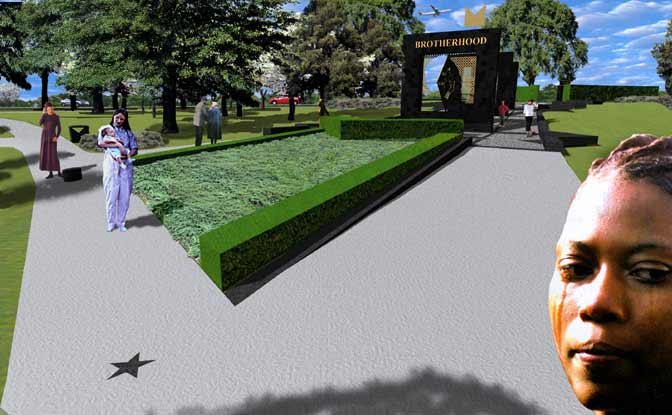 2001
2001GENERAL CONCEPT STATEMENT
The memorial deserves a simple beauty and profound significance. This design reflects the genesis of memorial markers in the assemblage of upright megalithic stones. These usually had some cosmic significance rooted in archaeoastronomy, yielding a temporal insight (e.g., Stonehenge, Carnac, Egyptian funerary sites). The stones of this memorial design possess such a chronometric essence.
VICINITY PLAN
The geometric layout works with the genius loci in a synergy with the memorials of the Washington mall, enhancing both the new memorial and its environmental context. One way in which this synergy is actualized is by reinforcing the kite plan axis between the Lincoln and Jefferson Memorials. The memorial is a synthesis of the circle and the square which is also the geometric nature of the site boundary.
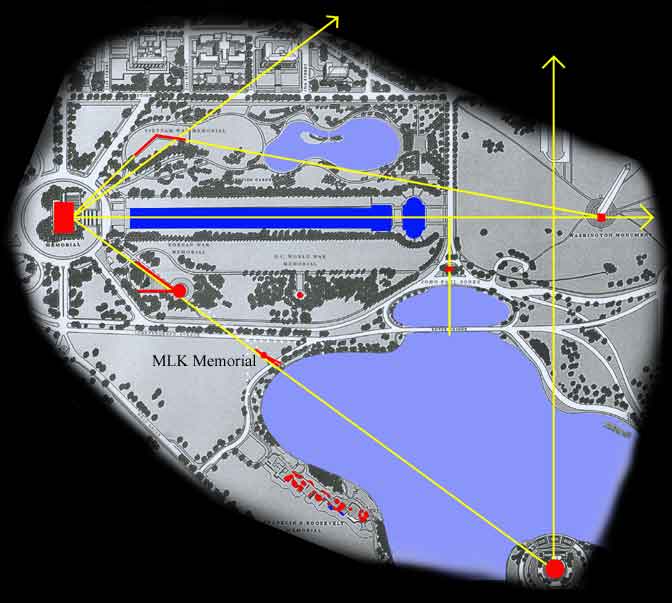
SITE PLAN
The design of this memorial has the following main features:
the Presidents’s Stone entry - which symbolizes a division (of the path) progressing to unity;
the Circle of Wholeness - where maximum closure and symmetry occur at the point of epiphany medallion;
frames with bronze image plates - these granite frames also epigraphically display significant quotes;
Brotherhood Square - the court where Dr. King’s statue resides
The memorial is designed to be syntactically Spartan while being semantically sophisticated. That is, by way of composition, it has formal simplicity, yet by way of symbolism, it is complex, profound, and rich in meaning. The simplicity should powerfully and immediately engage the attention of all observers. The complexity should lead the observers to a continued contemplative reflection revealing more profound levels of meaning through allegory, metaphor, and poignant aesthetic ambiguities.
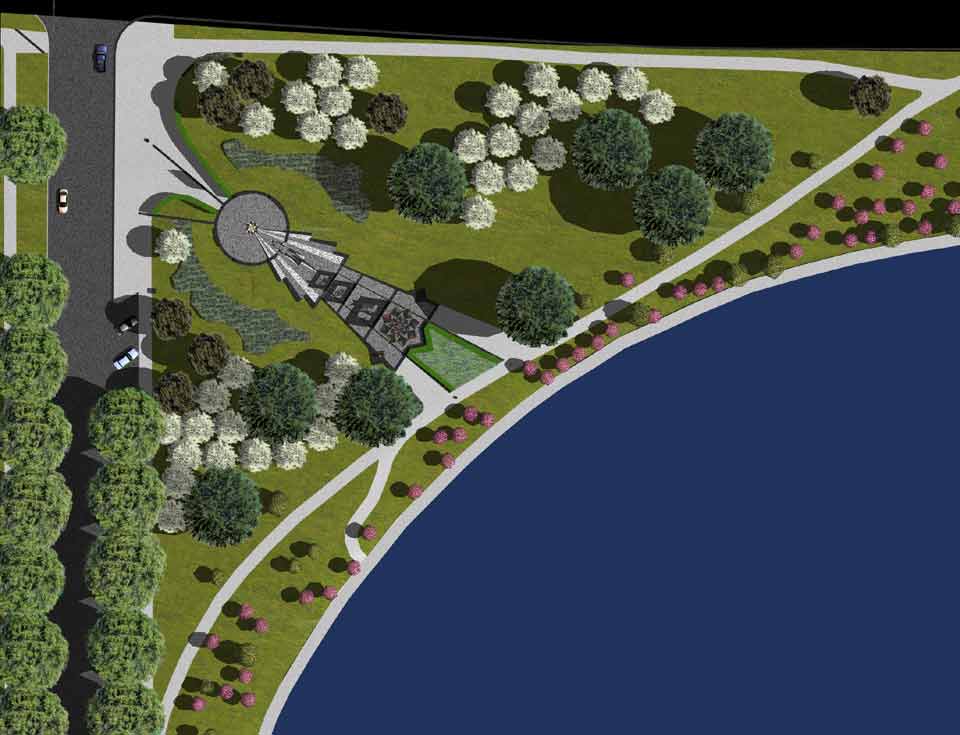
AERIAL VIEW FROM THE EAST
This aerial view shows the split entry from the east leading to the unity of the circle of wholeness. It also emphasizes the transitional relationship of the (brotherhood) square with the circle (of wholeness) which in ancient sacred geometry symbolizes harmony between the temporal world (the square) and the spirit world (the circle).
There is also an iconographic program which in its most significant parts uses resemblant imagery originating from the March on Washington, the climaxing event of Dr. King’s ministry. The framed facial image and the statue of Dr. King both emanate from a photograph of him on the steps of the Lincoln Memorial on that day of glory.
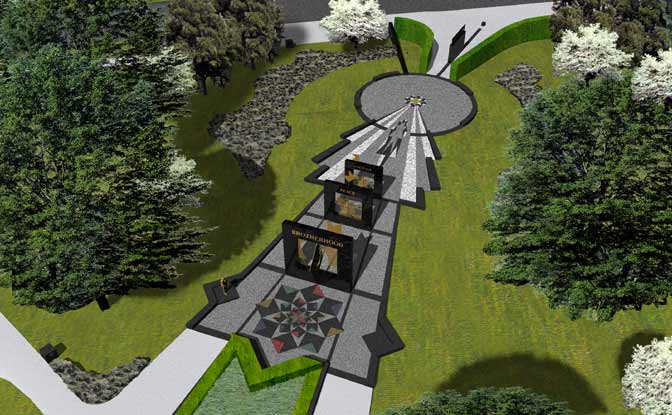
NORTHWEST CORNER
This aerial view emphasizes the conditions of compression and release at the entry and the focalization towards the point of epiphany in the center of the circle of wholeness.
(rollover) This provides a goal establishing glimpse of the memorial between the site’s identification sign and the topiary yew entry hedge. Further beyond on the walk you can see the golden section black granite block which proportionally abstracts the Lincoln Memorial temple. Further away the sunset ray of martyrdom stretches onto the walk and is abruptly broken-off (a rhetorical aposiopesis) at the granite pavement cross.
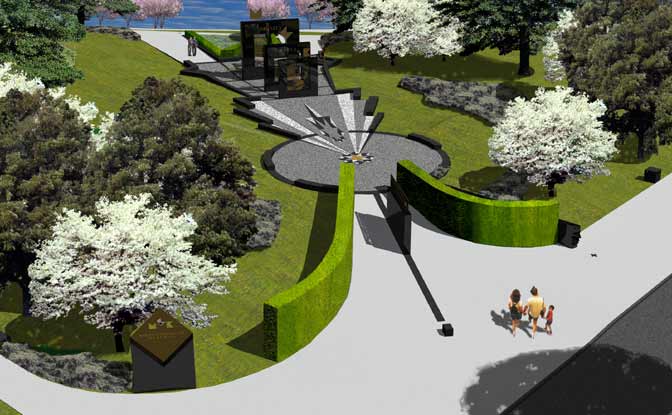
THE RAY OF MARTYDOM
This view from the west; shows the black granite wall extending onto the walk in the direction of the setting sun on the date of Dr. King's assasination and forming a poignant self-conscious encounter from the southern approach. The jagged nature of the break denotes a violent ending and the opposition of the facial profiles suggest an inherent conflict as is appropriate for introducing a place conceived to recognize the (negative) physical loss of a great leader simultaneous with the (positive) celebration of his ideals and mission.
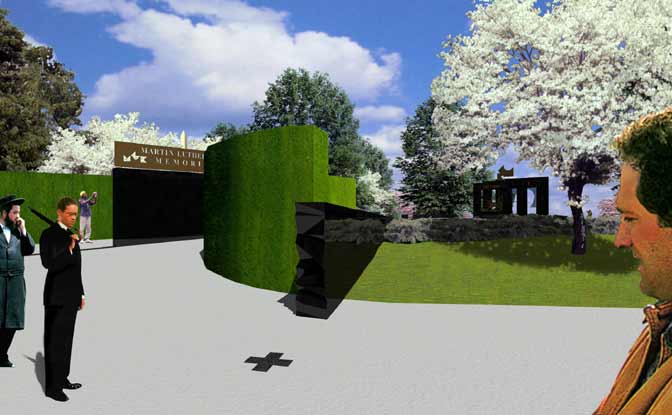
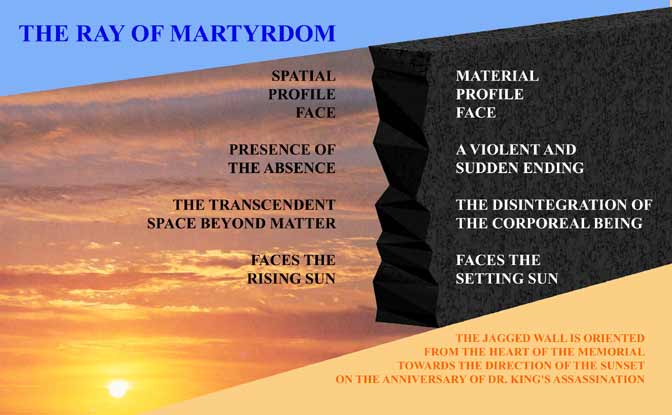
THE PRESIDENTS’ STONE ENTRY
This shows the compression threshold which focalizes our view and enhances anticipation for the emerging arrival and climax.
ANIMORPHOSIS
An anamorphic image is one that requires a particular and uncommon point of view for a coherent closure. Anamorphic graphic elements are not visually resolved from a wide range of positions in front, but are dramatically resolved from one precise viewpoint. Viewing a perspective projection from points of view not originally intended nor consistent with the original projection may look strange and distorted, but this leads the observer to seek the point of view which brings a harmonious closure to the previously perceived discordance of the elements.
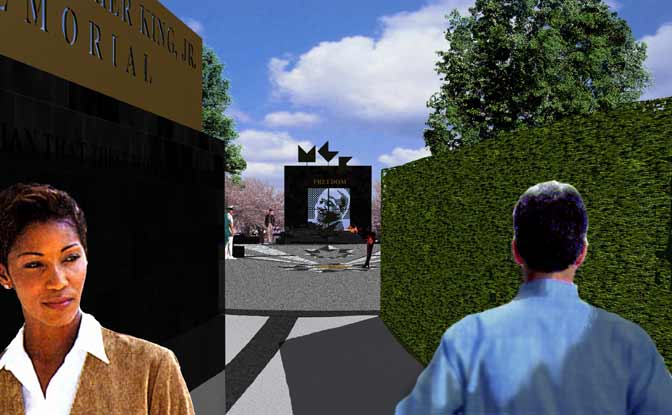
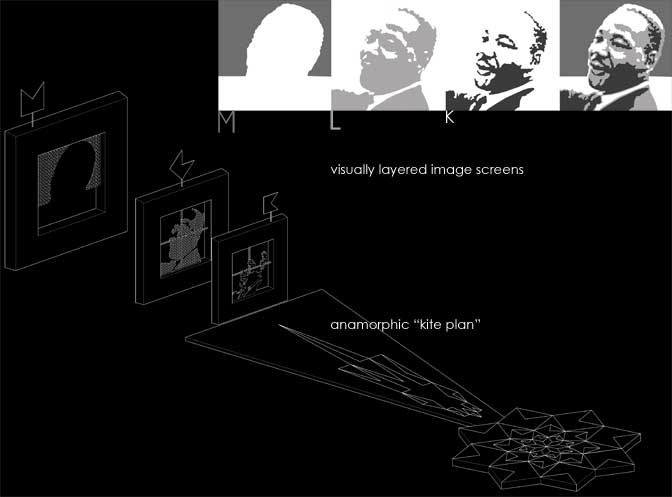
THE CIRCLE OF WHOLENESS
This view, just southwest of the climax viewpoint, emphasizes the apparent distortion of the pavement tessellation tiles and shows the central bronze epiphany medallion disk; note the “M-L-K” notched square bronze plates at the sky connection seem jumbled and incoherent.
THE POINT OF EPIPHANY MEDALLION (rollover)
At the origin of the circle of wholeness is the four foot diameter bronze medallion legend which marks the precise place to stand to visually resolve the perspective imagery towards the east. It has ciphers in relief which provide insight to some of the key elements of the memorial. Here “the vision of Dr. King” becomes whole and is most articulated as an allegory of his instrumental role as the focus of the civil rights movement (and the historical parallel this represents with his namesake, Martin Luther, who led the social revolution of the reformation at the time of the invention of scientific perspective projection).
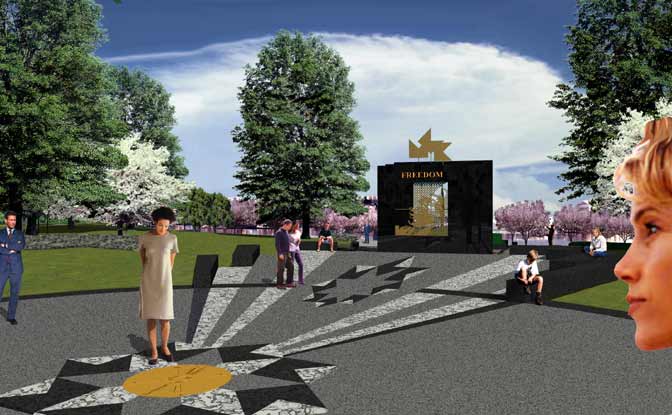
THE POINT OF EPIPHANY
Here the formal composition and narrative elements achieve maximum climax & closure. Atop the walls, the three notched squares constellate into the letters “M”, “L”, & “K”. The framed wall elements accord to make a three tone image of Dr. King as he appeared on the steps of the Lincoln Memorial to give his famous “I have a dream” speech. To the right and beyond, the statue of Dr. King assumes the same pose. The framed apparition suggests a pixellated television view; while the statue is a tactile, approachable reality. The pavement tessellation is in perfect symmetry forming a stellar union of two squares which seem to rise from their material/corporeal anchor in the pavement and echo the bronze letterforms in ascending heavenward to a higher plane. Under your feet, the bronze medallion explains the orientation rays of the memorial and repeats the of the “M-L-K” pattern.
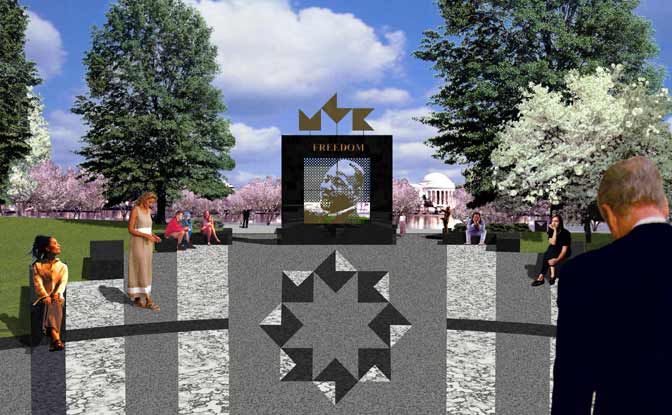
AUTOSTEREOGRAM OF THE CLIMAXING VIEW FROM THE POINT OF EPIPHANY
These images can simulate the layered 3-D layering if you cross your eyes so that your left eye focuses on the right image and your right eye on the left.
The pavement tessellation in front of the frames is anamorphically projected so that from the point of epiphany (i.e., the central climaxing viewpoint for the layered frame image) it appears to be rising up instead of lying down. This allegorically conveys the legacy of Dr. King’s work and its indomitable rise. It is an element of spirit which defies material repression and takes flight through the human spirit.
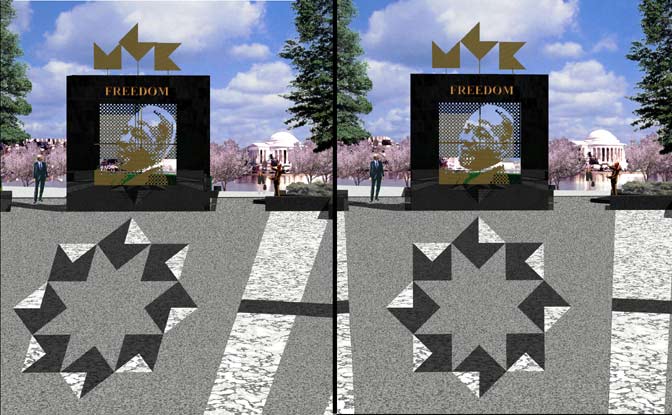
THE MANY LAYERS OF DR. KING
This oblique orientation shows the various elements of the framing walls and provides a preview of the “I have a dream...” diamond shaped bronze plate with Dr. Kings profile facing the rising sun of the east.
FRAME WALL CLOSE-UP
(rollover) Looking back towards the entry through the first/smallest frame wall which has the shadow elements, you can see extreme distortion in the tessellation paving tiles which are here viewed in reverse anamorphic perspective.
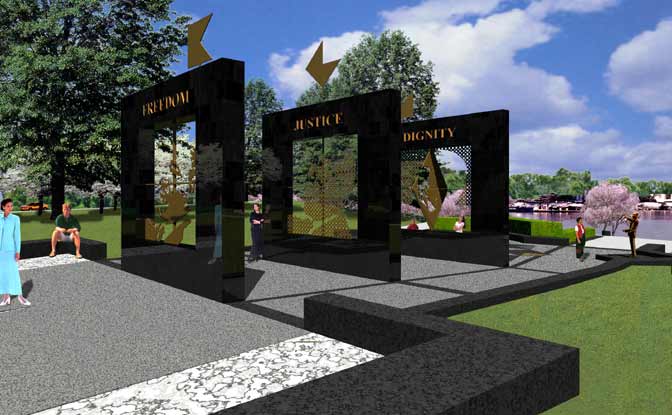
BROTHERHOOD SQUARE APPROACH
This shows the approach to Dr. King’s statue presiding over Brotherhood Square. Both the diamond profile plate and the statue gesture towards the east and its symbolic reference to growth, resurrection, and new beginnings. The statue also gestures in the directions of the center of the square, the Jefferson Memorial, and the Washington Monument.
ENTRY FROM THE SOUTHEAST (rollover)
The “M-L-K” notched square plates from this approach are not all correct letter orientations so they are perceived more as abstract forms, and as such their formal axes of symmetry suggest a transition from a passive horizontal axis of the small more distant plate to the active vertical axis of the larger closer plate. They may be seen as a bird forms (e.g., doves of peace) and relate allegorically to the rising of the Phoenix from its ashes.
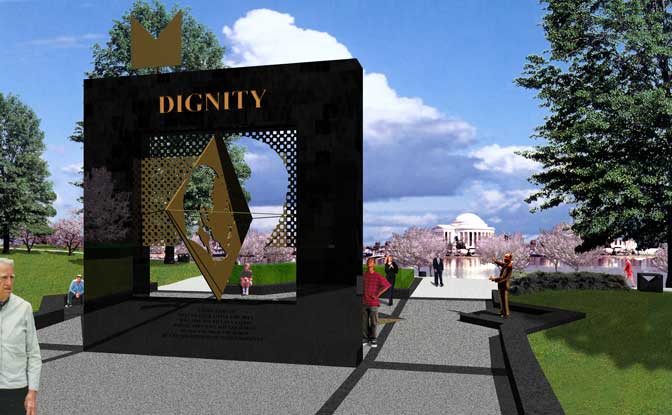
BROTHERHOOD SQUARE DETAILS
This dream-like view looks back towards the entry from the third/largest frame wall which has the background half-tone made from the squares and diamonds. The layering of disparate sized image elements draws out the theme of progression, emphasizing temporality, and suggesting the growth of the movement. The last frame suggests the presence of the absence of Dr. King with the large rounded void in the half-tone screen and the vertical acrostic reading of the text elements which could be read as “I had...”
NIGHT TIME VIEW(rollover)
This shows the night lighting effect on the diamond profile plate. The “M-L-K” notched square plates on the top would be lit from the west only since viewing from that side presents the letters in correct orientation.
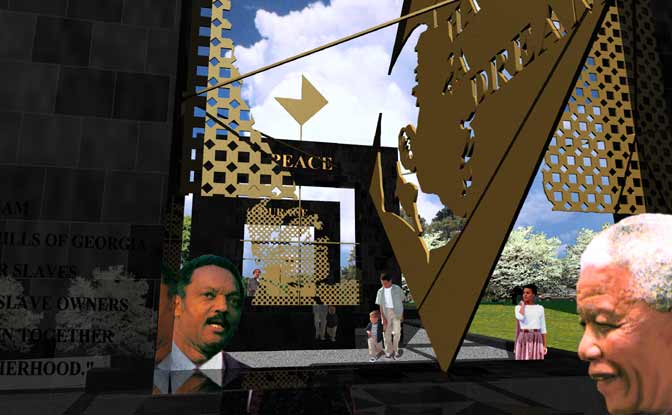
MATERIALS - CONSTRUCTION DETAIL
All the paving and small furnishing elements internal to the site are to be matt finished granite. The northwest site entry marker, the Presidents’ Stone at the west entry, the vertical faces of the ray of martyrdom wall, and the three large frame element walls are to be polished black granite. The entry marker and the Presidents’ Stone have half inch thick bronze plates with text identifying the site. The square vertical frame walls have bronze plates which produce an image of Dr. King when they are visually aligned. Epigraphs will be inscribed in the walls where they may have tactile access by visitors. Granite was chosen because it originates in the burning heart of the earth as molten magma and is transformed by this fire into a purified substance of crystalline temper. This not only makes it tremendously hard and durable for practicality of maintenance, but more poignantly it symbolizes unyielding firmness and endurance.
Concerning the Profile in the Big Bronze Diamond- Staring at this will induce a positive after image effect; this has subtle metaphorical significance as both the idea of looking back and seeing him as the great positive man he was, and the idea that his vision lives after him (the after-image effect). The bronze plates used in the imagery elements will sometimes appear light when they exhibit the brilliant specular reflection of daylight and other times they may look very dark as backlit silhouettes. Likewise, the image plate voids will vary depending on the lighting of the environment. This variability of appearance is metaphorical to the idea that the same essence may have any complexion. The profile image of Dr. King in the large frame has cut-outs for shadows while the other layered image composited in all three frames has solids for shadows. This positive-negative complementarity avoids a biasing of the imagery so there will almost always be one image that has realistic tonal contrasts at any given time under daylighting or night lighting.
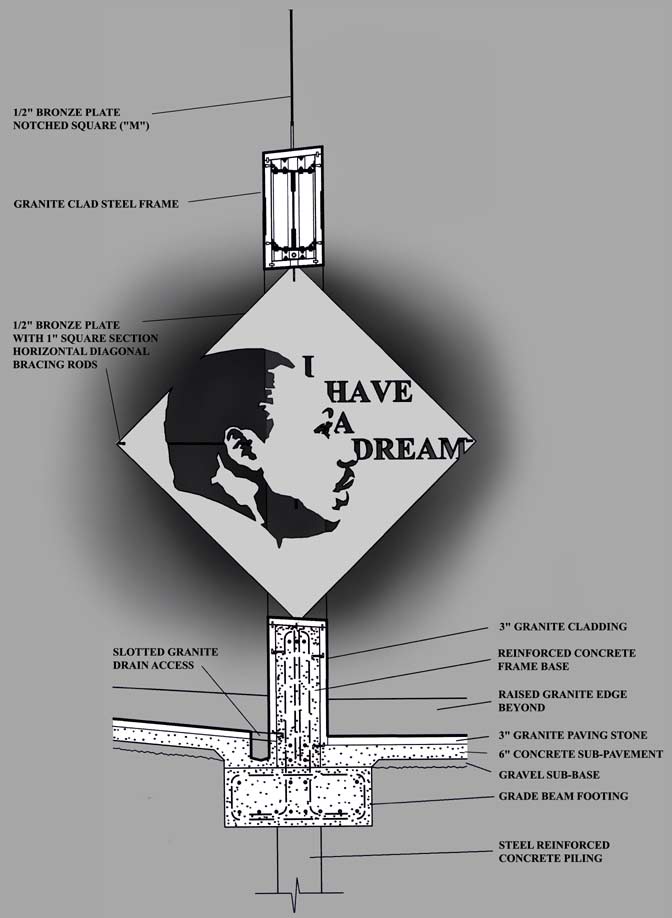
THE RAY OF NATIVITY
This entry approach from the east emphasizes the ray of nativity with its black granite star embedded in the walk pavement. This vector marks the horizon point of the rising sun (star) on each anniversary of Dr. King’s birth date. This ray gradually rises westward from the pavement as a gesture of growth and increase. Further back to the left you can see the black granite cylinder which abstractly references the Jefferson Memorial temple.
VIEW FROM THE JEFFERSON MEMORIAL (rollover)
This is a telephoto view as would be seen from the Jefferson Memorial.
